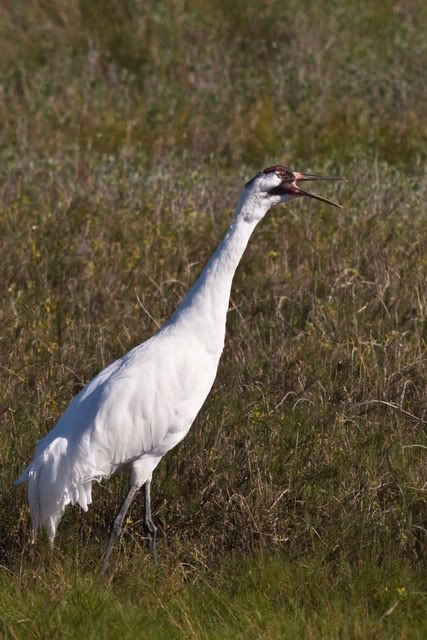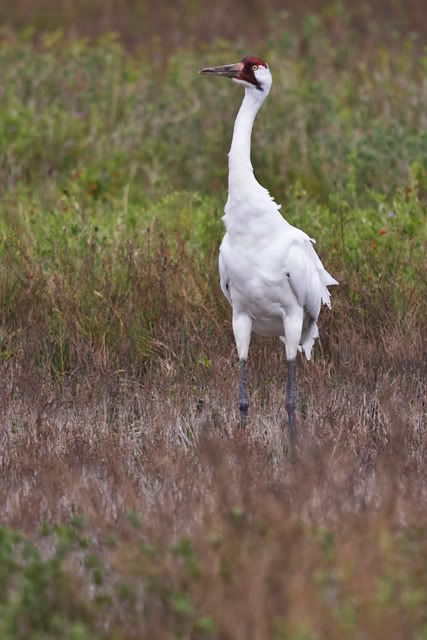First few Whooping Cranes from Aransas NWR
I chartered a boat to take us to see the whoopers which are not easily seen from Aransas proper. For photography the company I used was fantastic! He is a small operator out of Rockport; not one of the large Whooping Crane touring companies. He is much more flexible and really tried to get me in a good position for the photography. He had a shallow draft boat that allowed him to get where the larger boats could not. I have narrowed down my photos to about 20 definite keepers and 20 more that are iffy unless Photoshop can help them out. :wink By the way, the name of the company is Aransas Bay Birding Tours, located here: http://www.texasbirdingphotos.com/index.htm. I highly recommend them if you are ever in the area.
You probably already know this, but these whooping cranes are just two of only about 400 in the world and the wintering ones in Aransas NWR are descendants of just somewhere between 14-16 whoopers that were left in the world in 1941 when active conservation efforts began. The ones in Aransas represent the only true wild flock left since the other areas where you can find them, namely the group that summers in Wisconsin and winters in Florida are from whoopers that were reintroduced into the wild.
Here are my first few shots.

Higher res image is here: http://www.capture-the-pixel.com/gallery/3895123#225857610-X3-LB

Higher res image is here: http://www.capture-the-pixel.com/gallery/3895123#225857892-X3-LB
All of these were shot with my Canon 40D attached to my Sigma 500mm prime. I used a Manfrotto tripod and Wimberly Head II. These were shot from the observation deck of the boat.
You probably already know this, but these whooping cranes are just two of only about 400 in the world and the wintering ones in Aransas NWR are descendants of just somewhere between 14-16 whoopers that were left in the world in 1941 when active conservation efforts began. The ones in Aransas represent the only true wild flock left since the other areas where you can find them, namely the group that summers in Wisconsin and winters in Florida are from whoopers that were reintroduced into the wild.
Here are my first few shots.

Higher res image is here: http://www.capture-the-pixel.com/gallery/3895123#225857610-X3-LB

Higher res image is here: http://www.capture-the-pixel.com/gallery/3895123#225857892-X3-LB
All of these were shot with my Canon 40D attached to my Sigma 500mm prime. I used a Manfrotto tripod and Wimberly Head II. These were shot from the observation deck of the boat.
0
Comments
http://www.michaelhelbigphotography.com
http://www.thewildpig.blogspot.com
So the group that I was photographing at Necedah had to be hatched from eggs provided by your birds.
The trouble with the Whooping Crane is their size while using a long telephoto lens. You are never close enough, and then when you are, you are too close.
I was so close, while at 560mm, that when six of them flew right over my head that I could not get a focus. They were closer than the minimum focusing distance. Still...it was very nice to have observed them at close range.
I'll look forward to seeing more.:D
Bugs
Spiders
Flowers
Thanks Mike. It was a great experience. I plan on going back next year to see if I can get some better BIFs. I was amazed at just how big they are. I knew they were 5 feet tall, but until you see one in the wild, it is quite hard to believe they are that big.
www.capture-the-pixel.com
Luckily I did not have that problem. Most of the day the cranes and all other animals that day were quite far away. I would estimate that in these shots I was about 25-30 yards away. That was about the closest we could get.
And yes, at some point the whoopers in Necadah are related to these. In fact, part of the problem with the whoopers is the limited gene pool along with loss of habitat. Climate change and rising sea levels are definitely going to affect them even more.
www.capture-the-pixel.com
Thanks BigAl. I had to tone down the whites a bit more in Photoshop in some shots. I think I probably shot at somewhere between F5.6 and F9 for most shots depending on the sunlight.
www.capture-the-pixel.com
Dave
http://behret.smugmug.com/ NANPA member
How many photographers does it take to change a light bulb? 50. One to change the bulb, and forty-nine to say, "I could have done that better!"